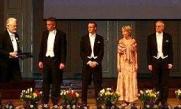Many acid resistant spherical microfossils have been recorded in sediments ranging from the early pre-Cambrian to Recent.
Leiosphere is a common name without taxonomic implications for thin-walled smooth or slightly ornamented spherical microalgae. The botanical affinities of leiospheres are unknown.
Simple, thin-walled spheres, like Leiosphaeridia, may develop in a variety of algal taxa. When found as fossil remains, these spheres may appear morphologically undistinguishable, despite they are naturally unrelated.
No features used for classification of modern algae—even at the rank of class—are preserved in fossil leiospheres. It is evidently impossible also to discriminate between different morphological appearances due to ontogenetic variability and environmental modifications. Consequently the leiospheres must be arranged in an artificial system without biological implications, but as far as possible according to biological principles.
Above the rank of genus leiospheres have been placed in morphologic groupings that are outside the sequence of ranks of taxa treated under the International Code of Botanical Nomenclature. They are not determined by means of nomenclatural types and not based upon priority of publication. Thus, all such groupings are equally applicable. The name acritarch meaning “of uncertain origin” was used by Evitt in 1963.
As morphologic groupings above the rank of genus in a completely artificial scheme of classification do not reflect any natural or genetical relations, the genera may better be arranged and discussed simply in alphabetical order. This may be particularly relevant because the algal cell may display a variability of shape during the life cycle.
The taxonomic classification is hazardous and complex in this group where the only features for classification are wall structure, ornamentation, and opening mechanisms. These features are not sufficient for a classification to modern algal taxa above the rank of species—not even at the rank of class.
Ornamentation is the main taxonomic character in several genera in this complex group, and has been used also as a diagnostic character at the rank of genus. However, in classification of modern algae it is relevant only at the rank of species. Even size has been used in some taxa as the only character of diagnostic value.
The importance assigned to morphological characters for classification at the rank of genus or species appears merely to be a question of personal opinion. For modern algae neither shape or ornamentation, nor apertures are relevant taxonomic characters at the rank of genus.
The wide size range from 8 µm to 440 µm in Leiosphaeridia indicates that different natural groups are included in the genus, but in comparison with modern algae it does not exclude definitely, however, that it is a natural genus.
In the leiospheres there are many badly defined and partly superfluous taxa. Several species are synonymous because they have been assigned to different genera which are synonymous. Species overlap because of different interpretations of ranges of diagnostic characters among investigators. Inadequate illustrations and insufficient diagnoses have made identification difficult. Accidental and diagenetic features have been interpreted as taxonomically valid.
However, some forms of leiospheres are morphologically well defined and have a restricted variability, at least in the same stage of the life cycle. They are distinct form species, no matter the name and circumscription of the genus to which they may belong. These forms are considered useful for biostratigraphic correlations and age determinations, specially in the pre-Cambrian and lower Palaeozoic.
| FORWARD TO
Botanical affinities |
||
|
|
||
References
- Lindgren, S., 1981.
- Remarks on the taxonomy, botanical affinities, and distribution of leiospheres. (Summary in Russian) Stockholm Contrib. Geol., 38(1): 1—20. Stockholm. ISBN 91-22-00500-5. ISSN 0585-3532. — Buy at the lowest prices among books in Sweden.
- Lindgren, S., 1982.
- Taxonomic review of Leiosphaeridia from the Mesozoic and Tertiary. Stockholm Contrib. Geol., 38 (2): 21—33. Stockholm. ISBN 91-22-00502-1. ISSN 0585-3532. — Buy at the lowest prices among books in Sweden.
- Lindgren, S., 1982.
- Algal coenobia and leiospheres from the Upper Riphean of the Turukhansk region, eastern Siberia. Stockholm Contrib. Geol., 38 (3): 35—45. Stockholm. ISBN 91-22-00504-8. ISSN 0585-3532. — Buy at the lowest prices among books in Sweden.
- Lindgren, S., 1982.
- A new taxon of Leiosphaeridia (algae) from Upper Cretaceous clays, southern Sweden. Stockholm Contrib. Geol., 37 (11): 139—143. Stockholm. ISBN 91-22-00487-4. ISSN 0585-3532.
- Lindgren, S., 1984.
- A new taxon of Leiosphaeridia (algae) from Upper Cretaceous clays, southern Sweden. Stockholm Contrib. Geol., 39 (5): 139—144. Stockholm. ISBN 91-22-00517-x. ISSN 0585-3532. — Buy at the lowest prices among books in Sweden.
Web Link
Are the green algae (phylum Viridiplantae) two billion years old? by Bernard Teyssèdre, Paris. Notebooks on Geology, Article 2006/03 (CG2006_A03), September 19, 2006











Can I just say what a aid to seek out someone who actually knows what theyre talking about on the internet. You undoubtedly know find out how to carry an issue to light and make it important. More folks have to read this and understand this aspect of the story. I cant consider youre not more fashionable since you undoubtedly have the gift.